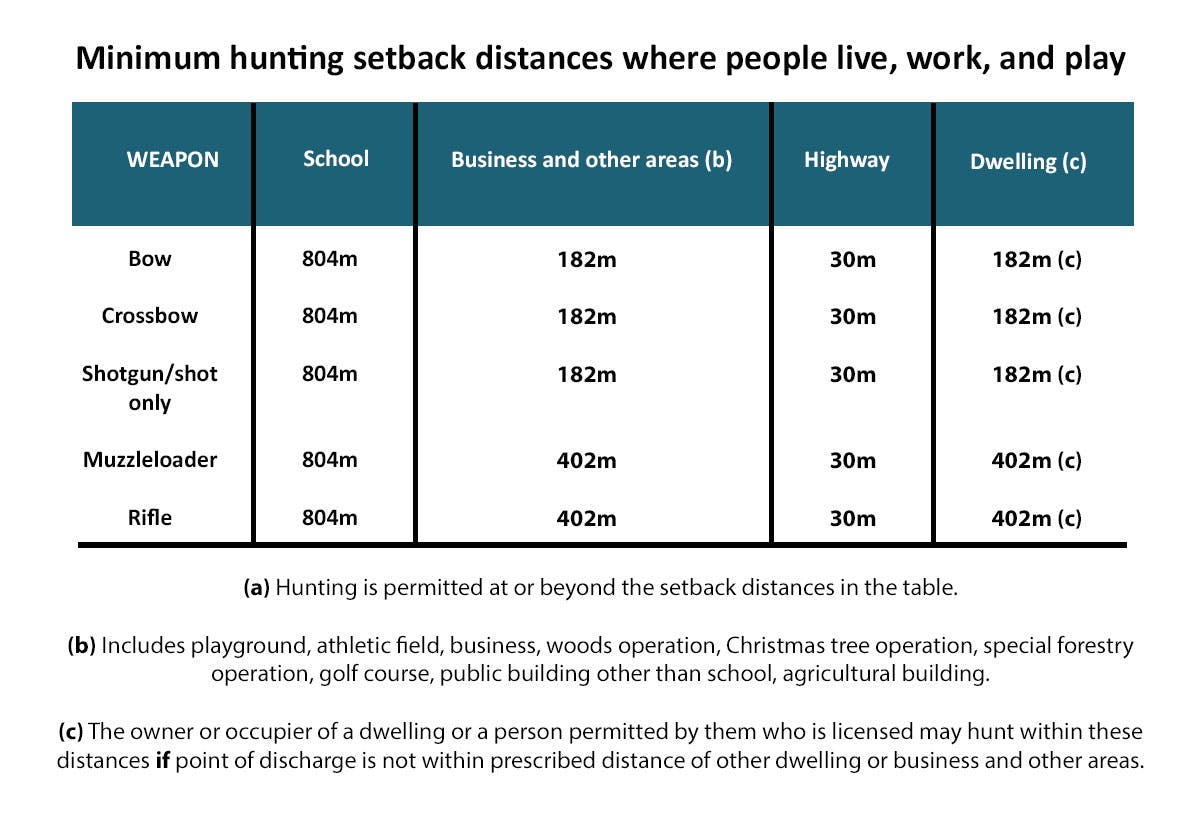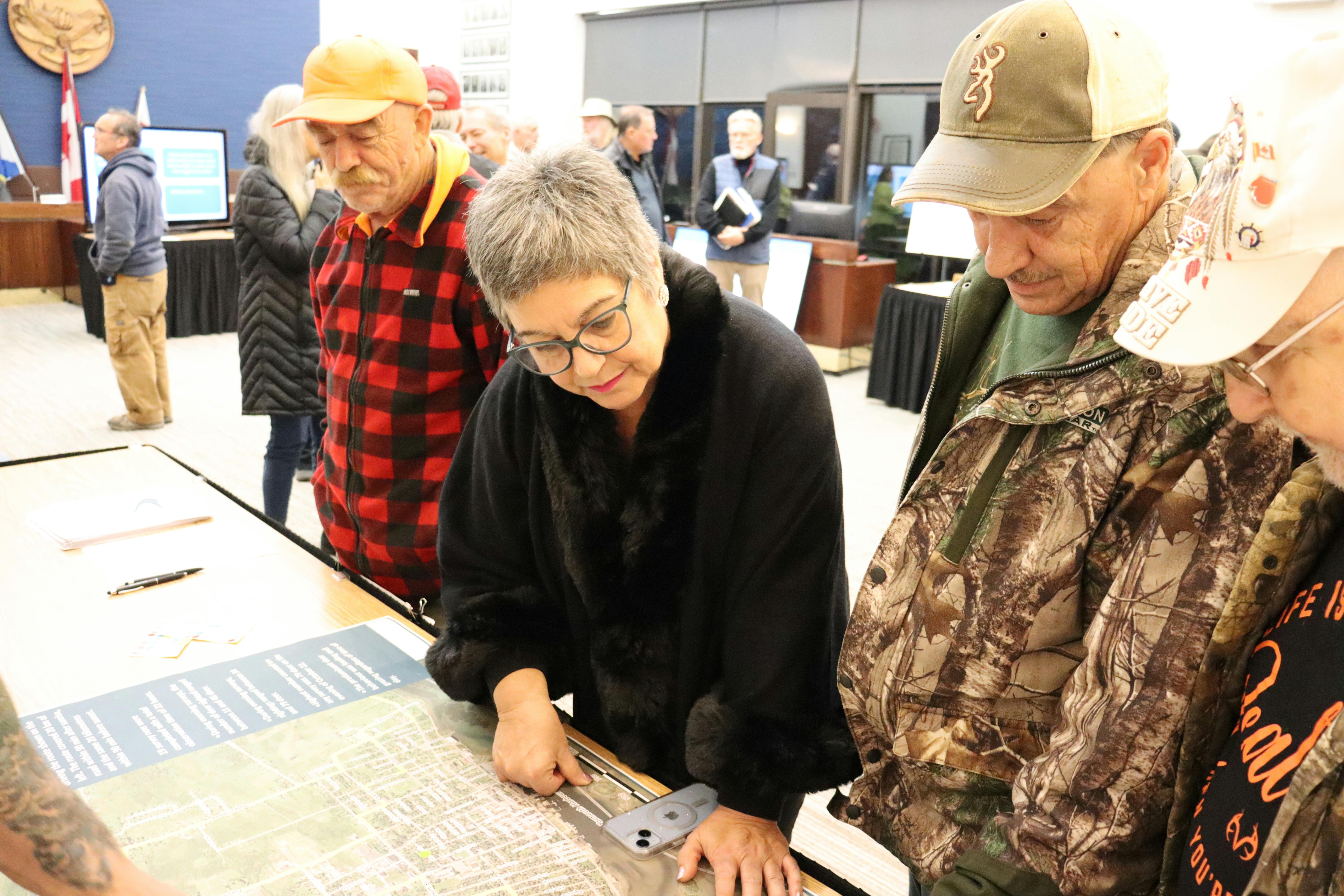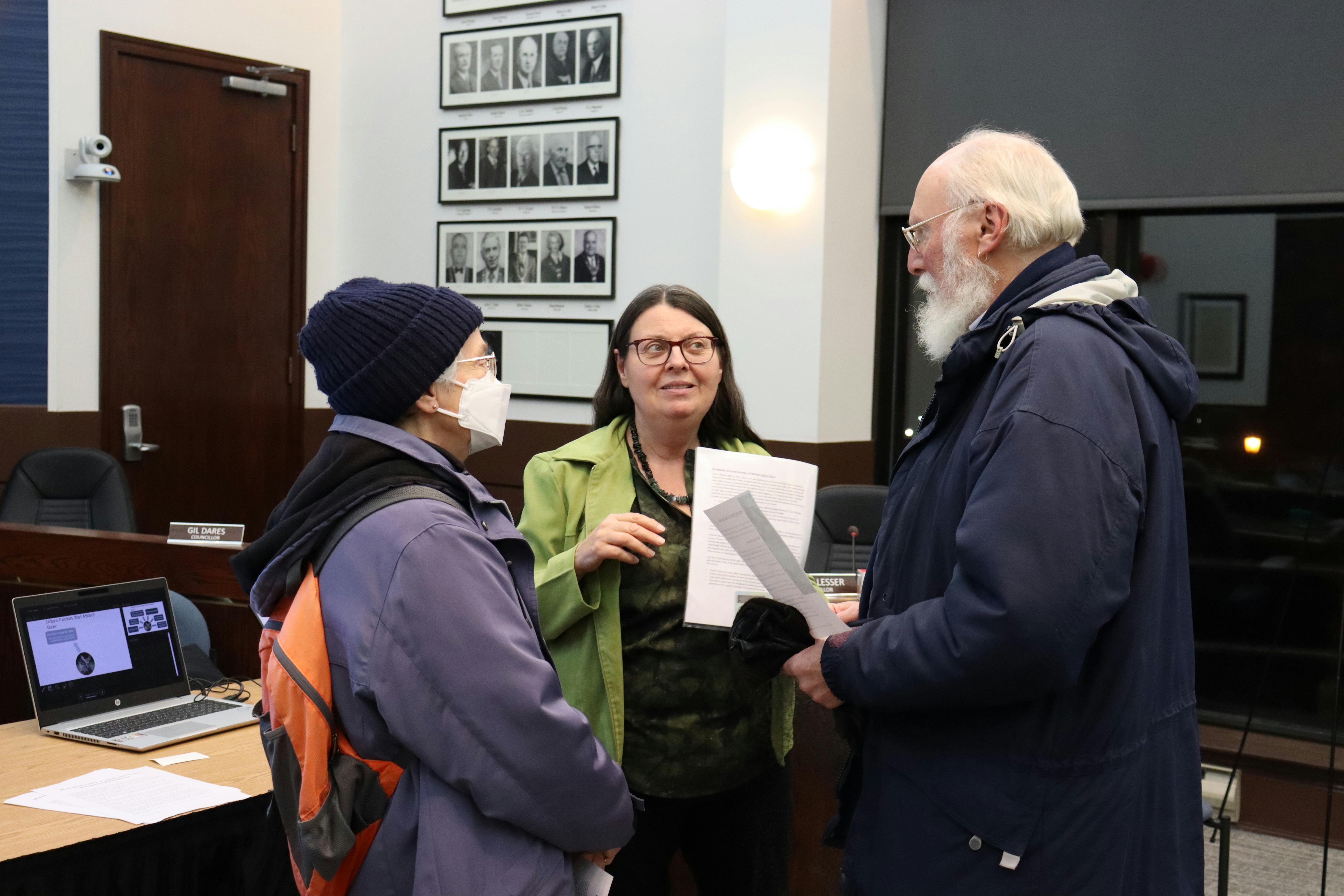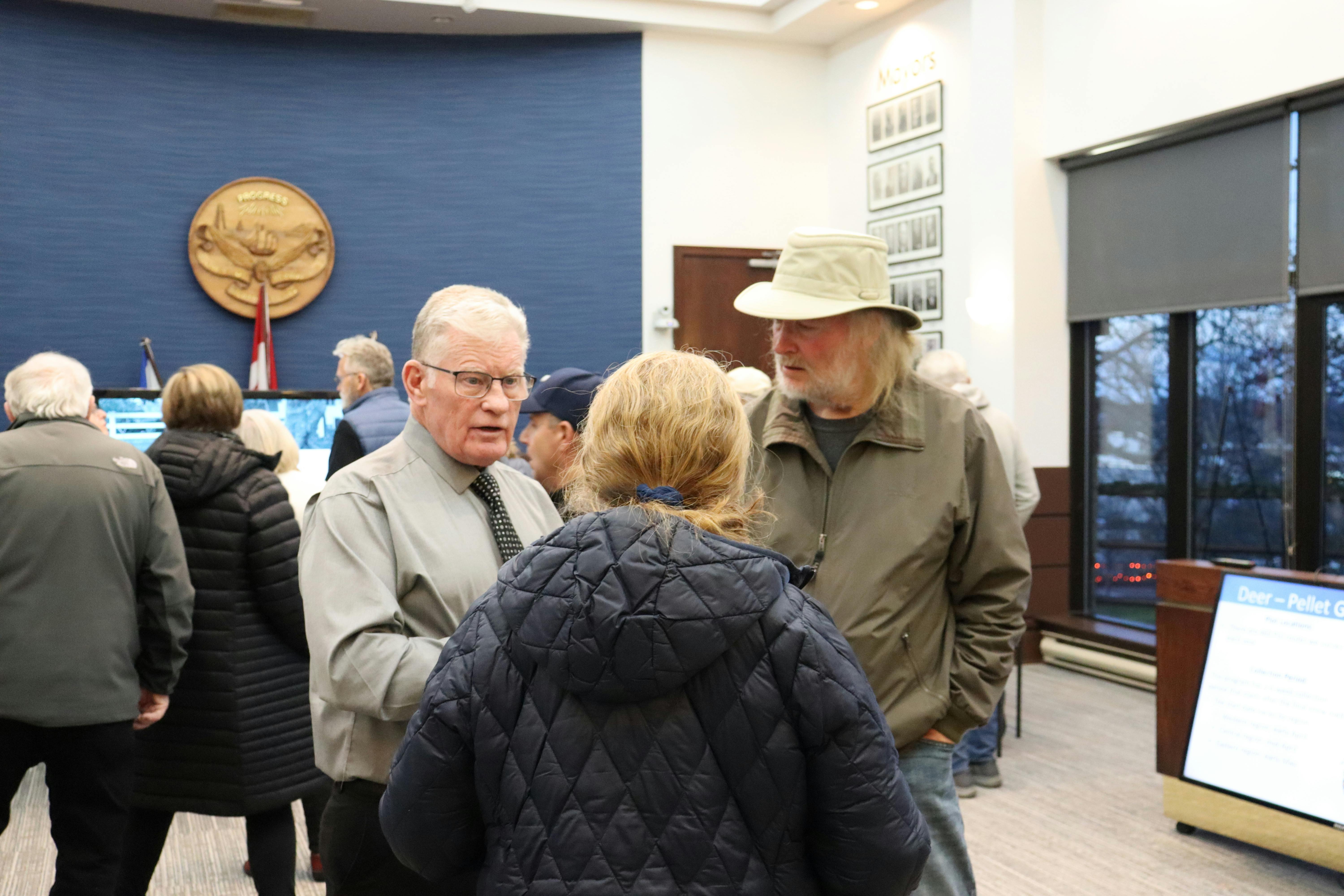After a year and a half of study and work, the town's deer management committee is recommending that Yarmouth Town Council submit a management plan to the Department of Natural Resources and Renewables (DNRR) that would include a controlled cull.
Urban Deer Management
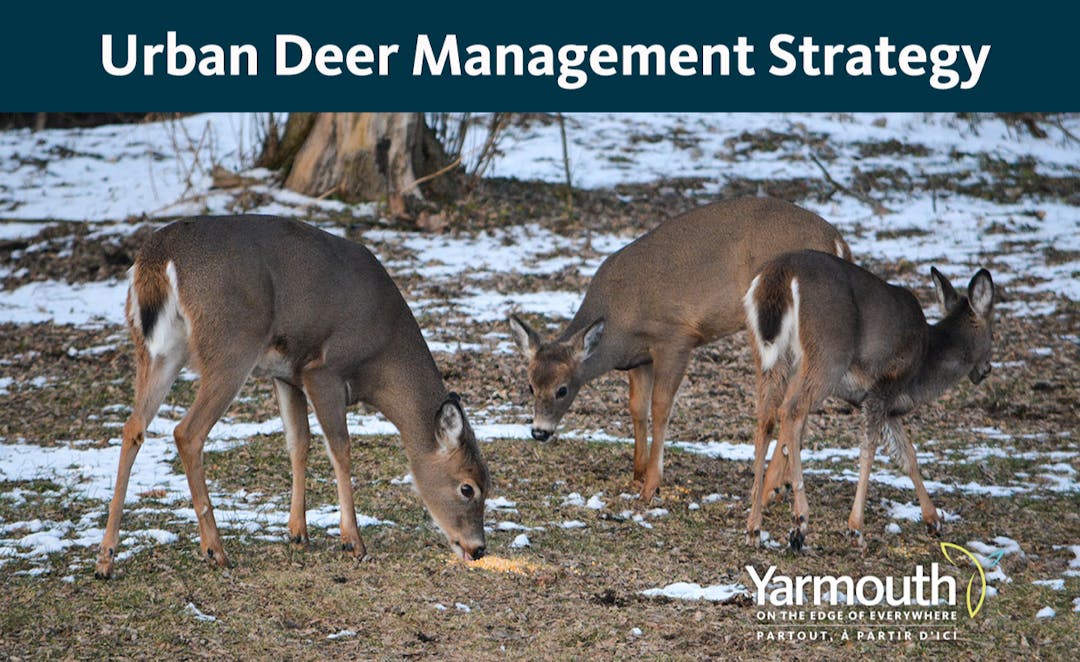
TO READ THE LATEST UPDATE, PLEASE SCROLL DOWN TO THE NEWS SECTION BELOW.
If you live or work in the Town of Yarmouth, it’s no secret that the deer population has grown in recent years. And not just by a small margin. In some cases, people are reporting seeing up to 15 deer in their yard at one time. While beautiful, they are becoming more and more of an issue each year. We are not alone, as many other towns across the province are experiencing the same problem.
Looking For Solutions through a Deer Management Strategy
At the April 14Continue reading
TO READ THE LATEST UPDATE, PLEASE SCROLL DOWN TO THE NEWS SECTION BELOW.
If you live or work in the Town of Yarmouth, it’s no secret that the deer population has grown in recent years. And not just by a small margin. In some cases, people are reporting seeing up to 15 deer in their yard at one time. While beautiful, they are becoming more and more of an issue each year. We are not alone, as many other towns across the province are experiencing the same problem.
Looking For Solutions through a Deer Management Strategy
At the April 14th 2022 Yarmouth Town Council meeting, a motion was passed to mirror the Deer Management Strategy developed by the Town of Truro. The strategy will address all issues related to the overpopulation of deer in town. This includes reducing problems with deer as they affect individual properties, offering public education, and exploring options for reducing the population. The strategy will be developed with oversight and guidance from Nova Scotia Department of Natural Resources and Renewables.
Creation of a Deer Management Working Group
A key step in implementing a Deer Management Strategy involves forming a Deer Management Working Group. The group includes town staff, Nova Scotia Department of Natural Resources and Renewables representatives, members of the community, and other experts. The group is looking at all sides of the issue to find short and long-term solutions.
With the formation of a working group, the Town of Yarmouth is moving forward in hope of developing a comprehensive strategy to solve the deer population issue.
Deer Management Group Members
Elected Official Members
Councillor Gil Dares (Chair)
Councillor Wade Cleveland
Appointed Members At Large
Tracey Parker
Freeman Libby
Department of Natural Resources
Deanna Nauss (Area Manager, Yarmouth /Digby), Tricia Fleming (Human Wildlife Conflict Biologist), Sian Wilson (Regional Biologist) – on leave
Town of Yarmouth Staff
CAO, Jeff Gushue
Municipal Clerk, Lindsay MacKinnon
Communications Coordinator, Mike Carter
Please check this page often, as we will provide updates on the working group's progress, and seek your input on key issues. You can also click the "STAY INFORMED - Subscribe for project updates" over on the right side of the page to receive updates.
-
Update from the Town of Yarmouth Deer Management Working Group
Share Update from the Town of Yarmouth Deer Management Working Group on Facebook Share Update from the Town of Yarmouth Deer Management Working Group on Twitter Share Update from the Town of Yarmouth Deer Management Working Group on Linkedin Email Update from the Town of Yarmouth Deer Management Working Group linkManagement Strategy Proposal Nearing Completion
The Deer Management Working Group is presently fine-tuning a proposal for submission to the Department of Natural Resources (DNR) seeking permission to conduct a controlled cull during the upcoming hunting season. The group’s first draft proposal, submitted in May of 2025, was deemed to be lacking in detail. The requested details are now being added, and a final proposal will be submitted soon.
Work Completed to Date
Leading up to this proposal, here are some highlights of the group’s work:
- Significant research has been conducted to explore all potential strategies to control the urban deer population. This includes options such as tranquilize and relocate, euthanize, trap/neuter/release, use of contraceptives, deterrence methods, limiting preferred forage, and more.
- A public survey was issued to gauge the extent of the deer population problem, the issues it creates for residents, and public sentiment around forming a population management strategy.
- A public information session was hosted by the Town of Yarmouth and DNR which attracted approximately 100 concerned citizens. The session allowed for one-on-one conversations to discuss the issue and possible management strategies.
- Several invitations have been honoured for a working group representative to attend meetings of concerned groups to provide information and updates.
- Feeding deer has been proven to make the problem worse. A bylaw prohibiting the feeding of wild animals was enacted by the Town of Yarmouth with potential fines up to $1000.
- Signage, social media posts, coverage by mainstream media and one-on-one engagement with the public have also been utilized to both glean information and provide status of our initiatives.
- In accordance with DNR requirements to provide statistical data indicating the size of the urban deer population and the trend over a period of three years, and with the knowledge that anecdotal information was not considered reliable, the Town of Yarmouth engaged a consultant to conduct a Pellet Group Inventory (PGI) in 2024 and 2025.
- To further support the claims of the number of animals in town, volunteers conducted a roadside count over a 14-day period which entailed traveling a prescribed route each day for one hour after sunrise and one hour before sunset documenting sightings and where possible age and sex of the animals.
- In support of a successful application, the group also gathered data regarding conflict with deer such as vehicle collisions, property damage, effectiveness of deterrence methods, etc.
- The group confirmed with the local food bank that they will accept meat that has been properly processed and wrapped for distribution to those in need, if a hunt is approved. An outlet for hides has been established for use in the creation of ceremonial drums. The compost facility has indicated they are prepared to accept the non-edible remains and jaw bones will be delivered to the Department for research purposes. Qualified hunters are being identified.
Work Still to Come
Our work continues, and the group is focused on finalizing the proposal to DNR. To receive authorization for a ‘Nuisance Wildlife Permit’ several conditions must be met, including:
- Permission of property owners where the population control will be conducted.
- Evidence that enough constituents have raised concerns.
- Reasonable prevention methods have been employed to mitigate the harm caused by the animals.
- That the Town of Yarmouth will not rely solely on population control but includes prevention and multiple management methods which are:
- Humane and supportive of deer health and welfare
- Supportive of sustainable deer management
- Compliant with all Provincial Acts and Regulations
- That the town has conducted at least one deer population survey using standard scientific methods (originally three years). We have now completed two.
- The proposal must also include details on how the Town will conduct prevention (education, fencing, plant selection) and why those methods are considered insufficient, on their own, to prevent damage.
- Finally, there needs to be a detailed plan of how the cull will be conducted.
Planning a Cull Within Very Limited Space
Planning a cull within town limits is the most difficult hurdle. We are frequently reminded that the Town of Truro has conducted hunts for several years. However, comparison of the municipal units will reveal distinct differences. The Town of Yarmouth (population 7000) is approximately 11 square kilometres while Truro (population 13,000) covers more than 37 square kilometres. Truro’s Victoria Park itself is approximately 1000 acres.
When conducting a hunt, specific distances must be maintained from any residences, schools, and businesses. For example, you must be at least 804 metres from any school, and 182 metres from any business or residence. You must also provide details regarding the precise locations of blinds, bait stations, shooting lanes, and access routes is a further requirement which must be satisfied. Given the size of our town, hunting location options are very limited and for the most part may not have an impact on the number of animals that live within town boundaries. We are in discussion on methods of enticing the urban herd to locations that may be approved for a controlled hunt to ensure some success. Finally, we must indicate whether we would plan to continue the hunt in subsequent years and how many animals would be targeted at each site.
PLEASE NOTE: To view a chart indicating the distances which must be maintained from any residences, schools, and businesses, as well as a map of the town showing the areas in which use of any weapon is prohibited, please see the section on this website called Maps & Charts (top right corner). You can also see them as images in the section called "Images & Photos".Final Thoughts
As a resident, we trust you can understand the complexity of this issue. In addition, we also recognize there are some who oppose any method which harms the animals, and their opinion must also be respected. Reducing the deer population will not eliminate the existence of the black legged tick which is responsible for the spread of Lyme disease as there are other hosts including birds and white-footed mice. This problem is not confined to our area but is prevalent throughout the province and North America. Nova Scotia, with its relatively moderate climate, ample food sources, lack of predators, and a decline in the number of seasonal hunters provides ideal conditions for the white tail deer which are not native to this province. Yarmouth unfortunately has an even more suitable climate (Zone 6B) for deer habitat.
Thank you for taking the time to read this update. More details will come soon. You can always find additional information and submit questions right here on this management group website.
-
PUBLIC NOTICE: Second Deer Pellet Group Inventory is being conducted in and around the Town of Yarmouth
Share PUBLIC NOTICE: Second Deer Pellet Group Inventory is being conducted in and around the Town of Yarmouth on Facebook Share PUBLIC NOTICE: Second Deer Pellet Group Inventory is being conducted in and around the Town of Yarmouth on Twitter Share PUBLIC NOTICE: Second Deer Pellet Group Inventory is being conducted in and around the Town of Yarmouth on Linkedin Email PUBLIC NOTICE: Second Deer Pellet Group Inventory is being conducted in and around the Town of Yarmouth linkFor the second straight spring, a wildlife management consultant company will conduct a Pellet Group Inventory (PGI) to evaluate the presence and abundance of deer in, and near, the Town of Yarmouth. This survey is necessary and will provide the town and Nova Scotia Department of Natural Resources and Renewables (NSDNRR) with a renewed reference point of deer densities in the town in 2025. The survey involves taking a deer pellet (droppings) inventory that will allow a comparative indicator of deer population density trend over a period time (typically two-three years). This PGI will also allow a measure of effectiveness of any population management actions which the town may decide to take in consultation with NSDNRR wildlife management staff. The team members of the consultant company will conduct the survey in, and near the town, in the same locations as last year's count. Work will be underway later this week and be carried out in two or three stints.Additional information regarding this PGI survey and approval of a population management plan:The Town of Yarmouth is more than aware of the overabundance of deer, and that deer can be found literally anywhere in town. That is why the Deer Management Working Group was created. The group has been working in partnership with NSDRR and has looked closely at ALL population management options. In November 2024, Town Council approved a motion to submit a population management plan to NSDRR, including a controlled hunt. That plan is being finalized now. To move forward and have the plan approved, this PGI must be undertaken. It is a requirement that ANY interaction with deer must be sanctioned by the NSDRR, and collecting this data is part of the process that needs to be followed. Without surprise, last year's baseline survey showed a high population density of deer within town. It is the hope of the Deer Management Group that this second PGI, combined with another roadside count, will provide the additional data needed to move forward with a management plan.You can find the summary of last spring's PGI in the "Key Documents" section to the right. -
Town of Yarmouth eyeing controlled cull to address its growing deer population problem
Share Town of Yarmouth eyeing controlled cull to address its growing deer population problem on Facebook Share Town of Yarmouth eyeing controlled cull to address its growing deer population problem on Twitter Share Town of Yarmouth eyeing controlled cull to address its growing deer population problem on Linkedin Email Town of Yarmouth eyeing controlled cull to address its growing deer population problem linkNot everyone around council table agrees this is the route to goarticle by Tina Comeau, PNI Atlantic - Published Nov 21, 2024YARMOUTH, N.S. While it's widely agreed that the Town of Yarmouth has a problem with a seemingly ever-growing deer population, agreement on what to do about it is not unanimous.
Click here to read the full article: https://www.saltwire.com/atlantic-canada/town-of-yarmouth-eyeing-controlled-cull-to-address-its-growing-deer-population-problem-101008553
-
Deer Baseline Survey
Share Deer Baseline Survey on Facebook Share Deer Baseline Survey on Twitter Share Deer Baseline Survey on Linkedin Email Deer Baseline Survey linkA wildlife management consultant company is assisting the Town with completing a baseline survey of deer presence and abundance.
Over the last year, the Town of Yarmouth's Deer Management Working Group has been working on developing a Deer Management Strategy. To help assist moving plans forward, a wildlife management consultant company is assisting the Town with completing a baseline survey of deer presence and abundance in deer habitat areas in, and near, the Town of Yarmouth. This survey will provide the Town of Yarmouth and Nova Scotia Department of Natural Resources and Renewables (NSDNRR) with a reference point of deer densities in deer habitat in the Town in 2024. The survey involves taking a deer pellet (droppings) inventory that will allow a comparative indicator of deer population density trend over the next few years. This baseline survey will also allow a measure of effectiveness of any population management actions which the Town may decide to take in consultation with NSDNRR wildlife management staff.
The team members of the consultant company will be conducting the survey in, and near the town, in a number of locations. Work will be underway later today (Monday, April 8th) and be carried out in 2-3 stints until early May.
Here is some additional information regarding this baseline survey. The Town of Yarmouth is well aware that there is an overabundance of deer, and that those deer can be found literally anywhere in town. That is why the Deer Management Working Group was created. The group has been working in partnership with the Department of Natural Resources and Renewables (NSDRR), and has been looking closely at ALL population management options. As a requirement to move forward toward any viable management option, this pellet inventory must be undertaken. It is a requirement that any interaction with deer must be sanctioned by the NSDRR, and collecting this data is part of the process that needs to be followed.
You can find more information around the baseline survey decision from the meeting minutes and video of the March 12th special council meeting here: https://pub-townofyarmouth.escribemeetings.com/Meeting.aspx?Id=7c0c2f75-0517-4d18-8bab-f26c604dbc18&lang=English&Agenda=PostMinutes&Item=11&Tab=attachments
n excellent Saltwire article summarizing the deer population situation, and the public information session held last fall to discuss various management options, can be found here: https://www.pressreader.com/canada/tri-county-vanguard/20231115/281556590552227
-
Public Information Session
Share Public Information Session on Facebook Share Public Information Session on Twitter Share Public Information Session on Linkedin Email Public Information Session linkThe Town’s Deer Management Working Group is hosting a public information session on Tuesday, November 21st. Members of the group, including representatives from the Department of Natural Resources and Renewables (DNRR), will be in attendance to offer a variety of helpful information, and answer questions you may have around the deer population issue within the Town of Yarmouth. Information presented will include:- Information on deer resistant plants and other deterrent methods
- Deer vehicle collision statistics
- Deer pellet group inventory (PGI) and hunting statistics
- Map of the deer management area
- An update on work and progress made by the working group
Please Join Us!WHEN: Tuesday, November 21st, 5 - 7 pmWHERE: Yarmouth Town Hall, 400 Main StreetWHO: Deer Management Working Group & DNRR -
Deer Management Group Issues Public Survey
Share Deer Management Group Issues Public Survey on Facebook Share Deer Management Group Issues Public Survey on Twitter Share Deer Management Group Issues Public Survey on Linkedin Email Deer Management Group Issues Public Survey link
Wednesday, February 22, 2023 - Yarmouth, N.S. – The Town of Yarmouth’s Deer Management Working Group released a public survey earlier today. As part of the group’s plans to engage the community, the survey will gather input from the public to improve understanding of how the urban deer population affects the daily lives of residents, and to help the group make better decisions in the future.
Group Chair Gil Dares hopes the survey will help paint a clearer picture of how people are affected by deer, and how serious those affects are. “This survey will help us better determine how the community feels about the deer population. We obviously know there are issues, that’s why we are doing this work. But we’ve heard a variety of different opinions on the matter, and the goal of this survey is to actively engage with the community to gain better insight as we work toward developing a management strategy.”
The survey can be competed online at the group’s information and engagement website: https://getinvolvedyarmouth.ca/urban-deer-management/survey_tools/deer-management-survey.
Paper copies of the survey are also available at Town Hall, 400 Main Street, or you may receive a PDF printable version by emailing admin@townofyarmouth.ca.
###
-
Deer Management Group Holds First Meeting, Plans a Path Forward
Share Deer Management Group Holds First Meeting, Plans a Path Forward on Facebook Share Deer Management Group Holds First Meeting, Plans a Path Forward on Twitter Share Deer Management Group Holds First Meeting, Plans a Path Forward on Linkedin Email Deer Management Group Holds First Meeting, Plans a Path Forward linkThursday, October 13, 2022 – Earlier this year, council passed a motion to begin the process of finding solutions to the town’s overpopulation of deer. The motion laid out a plan to follow the Deer Management Strategy developed by the Town of Truro, to help address all issues related to deer in town. A key part of the strategy is to form a Deer Management Working Group, which was created over the summer. The group recently held their first meeting, and began to set a path forward to find solutions.
The meeting involved an introduction of members, the selection of a Chair, and a thorough review of the group’s terms of reference. The terms of reference outline the group’s purpose and objectives, and a step-by-step process to develop, communicate, and implement the management strategy. The group also reviewed and discussed Truro’s management plan and timeline, deer data collection, and a future public Information session. The meeting closed with a review of the process and timelines, and a healthy discussion on the many issues created by deer within town limits.
“It was a great first meeting that allowed us to become familiar with each other, as well as the issues at hand”, said group Chair and Town Councillor Gil Dares. “Developing an effective strategy is going to take time as there are many steps we need to follow. Deer management has become an important issue, and this group is ready to get to work.”
The group plans to meet monthly, and will engage the public and offer updates on a frequent basis.
###
About the Deer Management Working Group
The group includes members of council, town staff, Nova Scotia Department of Natural Resources and Renewables representatives, members of the community, and other experts. The current group members are (with more members to be added):
Elected Official Members
Councillor Gil Dares (Chair)
Councillor Wade ClevelandAppointed Members At Large
Tracey Parker
Freeman Libby
Anne de GrosboisDepartment of Natural Resources
Deanna Nauss (Area Manager, Yarmouth /Digby), Tricia Fleming (Human Wildlife Conflict Biologist), Sian Wilson (Regional Biologist) – on leaveTown of Yarmouth Staff
CAO, Jeff Gushue
Municipal Clerk / Executive Assistant, Lindsay MacKinnon
Communications Coordinator, Mike Carter -
A cull? Something else? Controlling deer population to be explored by Town of Yarmouth
Share A cull? Something else? Controlling deer population to be explored by Town of Yarmouth on Facebook Share A cull? Something else? Controlling deer population to be explored by Town of Yarmouth on Twitter Share A cull? Something else? Controlling deer population to be explored by Town of Yarmouth on Linkedin Email A cull? Something else? Controlling deer population to be explored by Town of Yarmouth linkYarmouth looking to Town of Truro's experience as it seeks solutions to managing the deer population. Truro held a controlled cull earlier this year.
Tina Comeau | Posted: April 26, 2022, 6:24 p.m. | Updated: April 26, 2022, 8:30 p.m. | 9 Min ReadREAD THE FULL ARTICLE HERE: https://www.saltwire.com/atlantic-canada/news/a-cull-something-else-controlling-deer-population-to-be-explored-by-town-of-yarmouth-100722478/
-
Don’t Feed the Wild Animals! An important reminder as the town works on solutions to the deer population
Share Don’t Feed the Wild Animals! An important reminder as the town works on solutions to the deer population on Facebook Share Don’t Feed the Wild Animals! An important reminder as the town works on solutions to the deer population on Twitter Share Don’t Feed the Wild Animals! An important reminder as the town works on solutions to the deer population on Linkedin Email Don’t Feed the Wild Animals! An important reminder as the town works on solutions to the deer population linkIf you live or work in the Town of Yarmouth, it’s no secret that the deer population has grown in recent years. And not just by a small margin. In some cases, people are reporting seeing up to 15 deer in their yard at one time. While beautiful, they are becoming more and more of an issue each year. We are not alone, as many other towns across the province are experiencing the same problem.
One of those towns is Truro. To tackle the issue, Truro developed a Deer Management Strategy. A key ingredient of that strategy was the formation of a working group consisting of council members, town staff, and other community stakeholders and experts. The group has been successful in helping define the problem and build strategy to address it.
At the April 14th Yarmouth Town Council meeting, a motion was passed to follow Truro’s model and begin the process of managing the deer population by forming the same type of working group. This is an important first step toward finding a long-term solution to the town’s deer population problem.
Solutions from this working group will take time to develop. Until then, we can begin to address the problem by taking some actions of our own. In particular, avoiding the deliberate feeding of deer. Feeding wild animals in the Town of Yarmouth is not allowed under bylaw TOY 71 – “Feeding Wild Animals Bylaw”. Developed last year, a key purpose of the bylaw is to prevent the feeding of deer. Putting out food not only attracts other unwanted animals such as racoons and rats. It makes our deer problem worse as it causes them to gather unnaturally into groups of high densities. These high deer densities can:
- attract predators and increase risk of death by coyotes or domestic dogs.
- spread disease among deer and introduce lyme-disease carrying ticks to properties.
- cause aggression, wasting vital energy reserves and leading to injury or death.
- result in over-browsing of local vegetation and ornamental plants, including resident’s gardens.
- increase deer-vehicle collisions, a danger to both deer and motorists.
Feeding is bad for deer and bad for residents. While the town is now actively working on a solution to the deer population to protect the health and safety of citizens, please do not feed deer and other wildlife. The Feeding Wild Animals bylaw can be found on our website at townofyarmouth.ca/town-hall/by-laws.html. You may also request a paper copy at town hall, 400 Main Street.
Deer Management Options
-
 Deer Management Option - Capture and Euthanasia.pdf (2.11 MB) (pdf)
Deer Management Option - Capture and Euthanasia.pdf (2.11 MB) (pdf)
-
 Deer Management Option - Capture and Release.pdf (2.33 MB) (pdf)
Deer Management Option - Capture and Release.pdf (2.33 MB) (pdf)
-
 Deer Management Option - Fertility Control.pdf (2.56 MB) (pdf)
Deer Management Option - Fertility Control.pdf (2.56 MB) (pdf)
-
 Deer Management Option - Managed Urban Bow Hunt.pdf (1.28 MB) (pdf)
Deer Management Option - Managed Urban Bow Hunt.pdf (1.28 MB) (pdf)
-
 Deer Management Option - Surgical Sterilization.pdf (999 KB) (pdf)
Deer Management Option - Surgical Sterilization.pdf (999 KB) (pdf)
Key Documents
-
 Town Map - Minimum Hunting Setback Distances (7.57 MB) (pdf)
Town Map - Minimum Hunting Setback Distances (7.57 MB) (pdf)
-
 Chart - Minimum hunting setback distances (381 KB) (pdf)
Chart - Minimum hunting setback distances (381 KB) (pdf)
-
 Vanguard deer story - Town of Yarmouth eyeing controlled cull to address its growing deer population problem (287 KB) (pdf)
Vanguard deer story - Town of Yarmouth eyeing controlled cull to address its growing deer population problem (287 KB) (pdf)
-
 Deer Managment Working Group - Request for Counci Decision April, 2022 (221 KB) (pdf)
Deer Managment Working Group - Request for Counci Decision April, 2022 (221 KB) (pdf)
-
 TOY Deer Management Strategy - Terms of Reference (323 KB) (pdf)
TOY Deer Management Strategy - Terms of Reference (323 KB) (pdf)
-
 Urban Deer Management Presentation - Yarmouth Council 24 Mar 2022.pdf (4.45 MB) (pdf)
Urban Deer Management Presentation - Yarmouth Council 24 Mar 2022.pdf (4.45 MB) (pdf)
-
 Feeding of Wild Animals Bylaw (116 KB) (pdf)
Feeding of Wild Animals Bylaw (116 KB) (pdf)
-
 Public Survey Results (7.43 MB) (pdf)
Public Survey Results (7.43 MB) (pdf)
-
 Tri-County Vanguard Article - November 2023 (1.03 MB) (pdf)
Tri-County Vanguard Article - November 2023 (1.03 MB) (pdf)
-
 Tri-County Vanguard Article - December 2023 (274 KB) (pdf)
Tri-County Vanguard Article - December 2023 (274 KB) (pdf)
-
 Roadside Ground Survey of White-tailed Deer.pdf (2.08 MB) (pdf)
Roadside Ground Survey of White-tailed Deer.pdf (2.08 MB) (pdf)
-
 Urban White Tailed Deer Pellet Group Inventory Yarmouth Spring 2024 Final a.pdf (3.37 MB) (pdf)
Urban White Tailed Deer Pellet Group Inventory Yarmouth Spring 2024 Final a.pdf (3.37 MB) (pdf)
-
 Urban White Tailed Deer Pellet Group Inventory (PGI) 2025 (9.45 MB) (docx)
Urban White Tailed Deer Pellet Group Inventory (PGI) 2025 (9.45 MB) (docx)
-
 PGI Appendix 2025 (69.8 KB) (xlsx)
PGI Appendix 2025 (69.8 KB) (xlsx)


